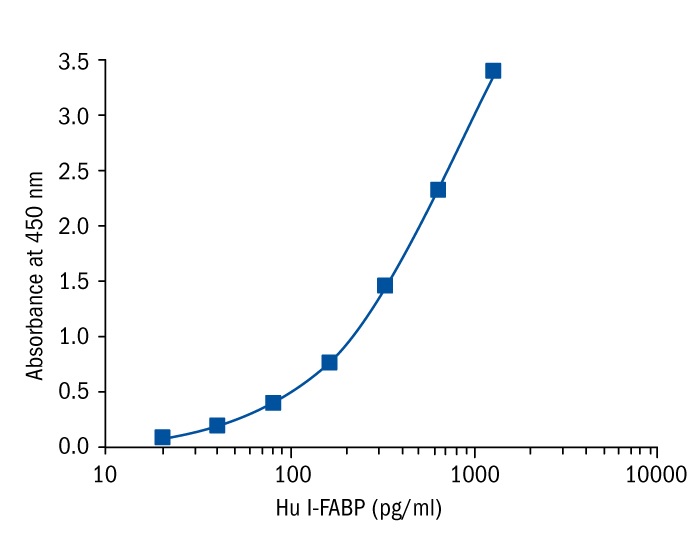Type
Sandwich ELISA, Biotin-labelled antibody
Applications
Serum, Plasma-EDTA, Plasma-Heparin, Plasma-Citrate, Urine
Shipping
At ambient temperature. Upon receipt, store the product at the temperature recommended below.
Storage/Expiration
Store the complete kit at 2–8°C. Under these conditions, the kit is stable until the expiration date (see label on the box).
Calibration Curve
Calibration Range
20 - 1280 pg/ml
Limit of Detection
3.5 pg/ml
Intra-assay (Within-Run)
n = 8, CV = 4.1%
Inter-assay (Run-to-Run)
n = 6, CV = 4.2%
Spiking Recovery
96.1%
Dilution Linearity
102.6%
Features
It is intended for research use only
- The assay time is less than 3.5 hours
- The kit measures I-FABP in serum, plasma (EDTA, citrate, heparin) and urine
- Assay format is 96 wells
- Standard is recombinant protein based
- Components of the kit are provided ready to use, concentrated or lyophilized
Research topic
Others, Animal studies
Summary
Intestinal fatty acid binding protein (I-FABP) or FABP-2, named after the tissue in which it was first identified, is one of the nine different FABPs characterized in mammals. The fatty acid binding proteins (FABPs) are 15 kDa cytoplasmic proteins, members of the superfamily of small intracellular lipid-binding proteins (LBPs). The primary function of all FABPs is regulation of long-chain fatty acid uptake and intracellular transport.
I-FABP is a cytosolic protein specifically present in mature enterocytes at the tip of the villus of small intestine and constitutes 2% of enterocyte proteins. I-FABP has high affinity for saturated and unsaturated long-chain fatty acids, and is believed to be involved in absorption and transport of dietary fatty acids. I-FABP has two forms: alanine-containing (A54) or threonine-containing (T54) protein which display differences in binding and transporting fatty acid across cells. The I-FABP genetic polymorphism Ala54Thr was found to be associated with increased fat oxidation, insulin resistance, elevated serum leptin levels, obesity and dyslipidemia in several populations, providing additional support for I-FABP role in energy metabolism and metabolic syndrome.
Serum concentration of I-FABP is low in healthy subjects, but upon enterocyte membrane integrity loss, I-FABP is released in the circulation and its serum level is rapidly increased. This makes I-FABP useful as a plasma marker for enterocyte damage and indeed, I-FABP has been promoted as a promising new serological marker for intestinal disease. Several studies have demonstrated the use of I-FABP for early detection of intestinal injury such as necrotizing enterocolitis, acute intestinal ischemia, gut wall integrity loss in viral gastroenteritis, small bowel obstruction or Crohn´s disease.
Thanks to its small size, I-FABP can quickly pass through the kidney to urine, which also gives an opportunity to measure it noninvasively in urine. A recent study found serum and urinary I-FABP levels are correlated with the length of resected bowel in infants with surgical treatment of necrotizing enterocolitis.Urinary I-FABP can also distinguish necrotizing enterocolitis from sepsis in early stage of the disease.
Find documents for the lot
Example Instructions for Use (RUO)
Example Instructions for Use (RUO)
Safety Information (RUO)
MSDS (RUO)
MSDS (RUO)

